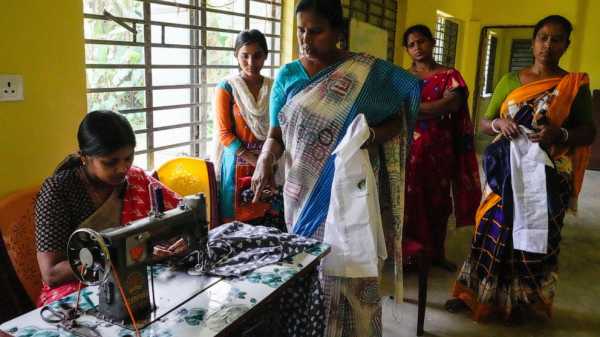
BENGALURU, India — For the second year in a row, India’s government has ordered the nation’s coal-fired power plants to run at full power. But this year’s order is even more sweeping than last year’s — all coal and oil-fired generators will be maxed out for the entire summer, from April through June. Analysts say it will dramatically increase India’s already sky-high greenhouse gas emissions.
Seventy miles from Kolkata in India’s West Bengal state, 48-year-old Kakali Halder knows the reason for the order. She and several hundred other seamstresses at Mathurapur Sanghati Swayamber Sangha, a group that make clothing items and share the proceeds between them, have struggled to get orders out when they can’t rely on the electricity.
Despite their proximity to the megacity of Kolkata, they lost power almost daily over part of last year’s blistering summer. The machines would go quiet, stopping progress on the uniforms they were on contract to deliver.
“Sometimes there were power cuts for up to 12 hours. We had to use the manual tailoring machines and stitch with our hands,” said Halder, the secretary of her group. They lost money they couldn’t afford to lose and endured pain working extra to complete work that should have taken half the time.
Cooling systems across the country, now more urgently needed as climate change turns up the heat on already sweltering temperatures, were exhausting the grid. Several northern states including West Bengal, Rajasthan and Gujarat faced regular power outages. The government order to keep the coal plants running is an example of a warming planet prompting action that further aggravates climate change.
India is the world’s second-largest country by population, and the third-largest emitter. It relies on its abundant coal — plus some imports — for some 70% of electricity. India has hundreds of coal-fired plants and mines dotted around the country. The government expects power demand to reach a high of 229 gigawatts in April.
India “has to ensure there is energy security as this is critical for the country’s development and growth,” said Alok Kumar, the most senior official in India’s federal power ministry. He said India is achieving its climate goals fully and will continue to do so.
But others see national politics influencing the call to run the generating stations — including the oldest or dirtiest-burning — at full power for the duration of summer. Major regional elections in the politically important southern Indian state of Karnataka will be held on May 10 and the national elections to elect a new prime minister will be held next year.
“There is a strong political incentive to ensure regular electricity supply this summer,” said Aditya Lolla, an energy policy analyst at the London-based environmental think tank, Ember.
Electricity availability and electricity subsidies acutely affect election results in India and incumbent political parties strive to provide uninterrupted supply, especially when there are elections around the corner.
Climate change doesn’t just make daytime heat waves hotter. It also often means that temperatures don’t cool down as much at night. That’s driving up demand for cooling in the evening hours, Lolla said.
India’s power consumption grew 10% this February compared to last. Records could be broken in the coming weeks.
India currently meets about 10% of its power need with renewable energy. While there is rapid growth in clean energy, it’s nowhere near enough to meet peak demand.
One thing experts agree is needed is a massive amount of new energy storage, usually large arrays of batteries. The idea for storage is that batteries charge from excess power on the grid during hours when demand is low. Currently, India has only 3 gigawatts of storage, or enough to serve about 3 million homes for a year.
“Energy storage is important to ensure uninterrupted supply during extreme weather as well as to shift firmly towards clean energy,” said Ammu Jacob, a scientist at the think tank Center of Study of Science, Technology and Policy. Jacob said without more storage it will be harder to integrate wind and solar energy into the grid even if new renewable energy projects come up, because of its intermittency.
One problem for building out storage has been cost, but costs are coming down, Jacob said. And the alternative, damages to lives and livelihoods due to climate change-driven extreme weather, is expensive too.
To accelerate India’s energy transition, “international climate finance is essential,” said Lolla of Ember.
The country will need to install more than 40 gigawatts of clean energy on average every year to meet its 2030 goal. But it needs a parallel plan to phase down coal-fired power, said Lolla of Ember. India has announced a net zero target for 2070, but its path to get there is still unclear, Lolla said. India fell just shy of meeting its target of 175 gigawatts of renewable energy by 2022.
But for those like Kakali Halder, the more urgent hope is that last year’s power cuts don’t return.
“All our customers are local and they understand if orders are delayed, but at the same time no one waits forever,” she said.
___
Follow Sibi Arasu on Twitter at @sibi123
___
Associated Press climate and environmental coverage receives support from several private foundations. See more about AP’s climate initiative here. The AP is solely responsible for all content.
Sourse: abcnews.go.com